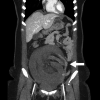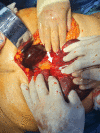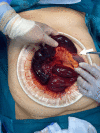Post-appendectomy Adhesive Small Intestine Obstruction With Gangrene: A Sinister Case
- PMID: 37378224
- PMCID: PMC10292044
- DOI: 10.7759/cureus.39437
Post-appendectomy Adhesive Small Intestine Obstruction With Gangrene: A Sinister Case
Abstract
Intestinal adhesions are fibrotic bands of scar tissue that develop intra-abdominally due to serosal or peritoneal irritation caused during surgery or by severe infections. It may also occur congenitally. It can lead to serious complications such as small bowel obstruction, which is then termed adhesive small bowel obstruction. In this scenario, it can constrict the bowel wall and cause ischemia and necrosis of the affected intestinal segment. Computed tomography imaging may show characteristic signs, such as the "whirl sign" or "fat-bridging sign." Diagnostic laparoscopy or laparotomy can confirm the diagnosis and presence of adhesions. Management of this condition is either conservative or surgical, the latter of which is necessary in the case of intestinal strangulation. While the literature supports the laparoscopic method of adhesiolysis, practically, it may present technical difficulties. Surgeons should employ their clinical judgment in cases where an open procedure may be more beneficial. We present a case of this very occurrence and discuss the risk factors, pathogenesis, diagnostic evaluation, and, finally, the approaches to surgical management of this condition.
Keywords: adhesions; band; gangrene; ischemia; obstruction; small intestine.
Copyright © 2023, Das et al.
Conflict of interest statement
The authors have declared that no competing interests exist.
Figures





References
-
- Intra-abdominal adhesions. [ Mar; 2023 ];Brüggmann D, Tchartchian G, Wallwiener M, Münstedt K, Tinneberg H, Hackethal A. https://www.ncbi.nlm.nih.gov/books/NBK470544/ Dtsch Arztebl Int. 2010 107:769–775. - PMC - PubMed
-
- The clinical significance of adhesions: focus on intestinal obstruction. Ellis H. https://pubmed.ncbi.nlm.nih.gov/9076446/ Eur J Surg Suppl. 1997;577:5–9. - PubMed
-
- Complete ileal transection: a rare complication of adhesive bowel disease— a case report. Atif QA. https://www.ncbi.nlm.nih.gov/pmc/articles/PMC6438903/ Int J Surg Case Rep. 2019;57:74–80. - PMC - PubMed
-
- Abdominal adhesions: a practical review of an often overlooked entity. Tabibian N, Swehli E, Boyd A, Umbreen A, Tabibian JH. https://www.ncbi.nlm.nih.gov/pmc/articles/PMC5295619/ Ann Med Surg (Lond) 2017;15:9–13. - PMC - PubMed
Publication types
LinkOut - more resources
Full Text Sources
